ELEPHANTS
Elephants are calm, friendly, and playful animals, known as the largest living land mammals.
They can be recognized from afar by their muscular bodies and noisy trunks. They exhibit characteristics of both intelligence and obedience. You may refer to them as obedient trunkers.
Scientific Classification of Elephants
Kingdom | Animalia |
Phylum | Chordata |
Class | Mammalia |
Order | Proboscidea |
Family | Elephantidae |
Types of Elephants
Only two genera fall in the family Elephantidae: one is Loxodonta, and the second is Elephas. There are three living species of elephants in these genera.
1- African savanna elephant (Loxodonta africana)
An African savanna may stand as tall as 12 feet (4 meters) at the shoulder. It weighs about 5442 kilograms (18,000 lbs) or almost 6 tons. From trunk to tail, it can grow to 30 feet (9 meters). It is the largest living land mammal. It is also called a bush elephant.
2- African forest elephant (Loxodonta cyclotis)
Forest elephant is smaller than the bush elephant. At the shoulder, it can be heighted up to 8.2 feet ( 2.5 meters). It may weigh around 2745 kilograms ( 6000 lbs) or almost 2.7 tons.
3- Asian elephant (Elephas maximus)
Asian elephants come second to African elephants. It can grow 18 to 20 feet (5.5 to 6.5 meters) in length and weighs 1800 to 5000 kilograms (4000 to 11,000 lbs) or almost two to five tons.
Asian species have further three subspecies;
- Indian elephant
- Sumatran elephant
- Sri Lankan elephant
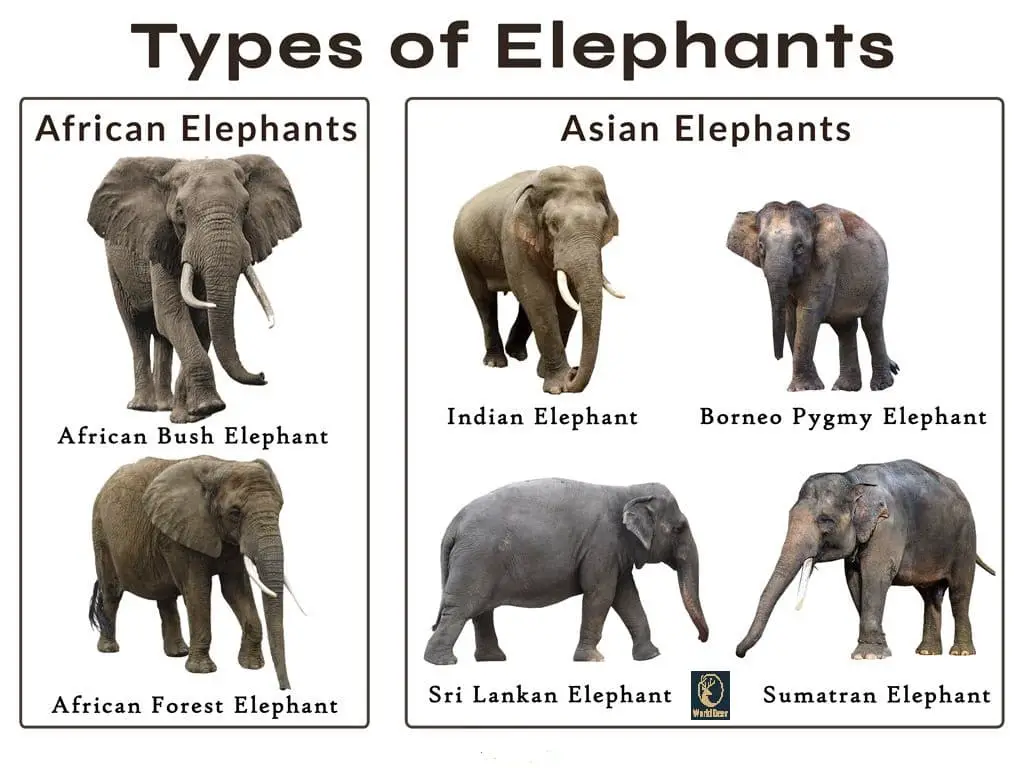
Physical characteristics
Trunk: An elephant’s trunk is essentially a nose or an enlarged snout. It is an extension of the upper lip and nose. It boasts remarkable abilities such as breathing, drinking, feeding, smelling, sensing, communicating, and grasping. Containing about 100,000 muscles, it is one of the most flexible appendages known.
Dentition: An elephant has 26 teeth, including 12 premolars, 12 molars, and 2 prominent, ever-growing incisors known as tusks. These tusks may be present in each species except for the Asian female elephants. Elephants without tusks are called Makhnas. African female elephants, in comparison, may have smaller tusks known as tushes.
Ears: Elephants have large flapping ears. The size varies within their geographical range, providing a keen sense of hearing and aiding in thermoregulation.
Skin: Their skin is gray-colored and wrinkled. While tough and rough, it is sensitive to touch. The wrinkles help them stay cool for extended periods. Their bodies also have sparse hairs.
Legs and Feet: Elephants have robust limbs. Their foot structure is such that they walk on their tiptoes, balancing their weight with connective tissue at the heel.
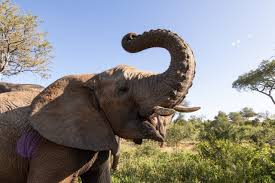
Elephant's trunk
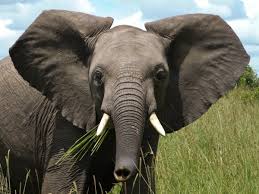
Elephant's Ears
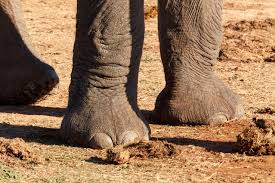
Legs and feet of Elephants
Distribution and Habitat
African elephants are distributed in sub-Saharan regions; bush elephants range from eastern to southern regions of Africa, while forest elephants are found from western to central regions. Elephants primarily tend to live in woodlands, savannas, and tropical forests. They are also found in a variety of habitats, including deserts and grasslands.
Asian elephants are primarily found in tropical rainforests. They are distributed throughout Southeast Asia and the Indian subcontinent, ranging from Borneo in the east to India in the west, and from Sumatra in the south to Nepal in the north.
Migration
Due to environmental conditions, elephants may migrate from one habitat to another. During dry seasons, they migrate towards grasslands where roots are plentiful. During rainy seasons, they move from deserts and woodlands to tropical rainforests.
Diet and Digestion
These giant tuskers are herbivores. They primarily feed on leaves, fruits, and roots. You could describe them as eating machines since they eat for 16 hours per day. Their daily food consumption ranges from 250 to 300 pounds, which can even exceed 600 pounds in the wild. An elephant consumes between 100 to 200 liters of water daily, or twenty-five to fifty gallons. The trunk is used as a drinking tool; it can hold up to 2.5 gallons of water and transfer it gradually to the mouth.
The intestine of an elephant is 60 feet (19 meters) long. Because they eat so much, they also defecate 12 to 15 times a day, amounting to about 200 pounds. They can urinate approximately 100 liters. The feces are only 50% digested, which aids in manure production. That’s why they are also known as manure manufacturers.
Behavioral Adaptations
Foraging behavior
These large creatures use their trunks as hands to grasp vegetation. They may walk about 6 to 8.5 km per hour in search of food. They crush large fruits into small pieces beneath their feet and then eat with the help of their trunks. They uproot vegetables and fruits and enjoy themselves while eating.
Social behavior
A group of elephants is called a herd. A male elephant is called a bull. A female elephant is called a cow, and baby elephants are called calves. A herd led by a matriarch leads other cows and their offspring. There may be six to twelve members in a family. The bull joins the group or lives alone.
Communication
They can communicate through vocalizations. They can roar, bark, growl, scream, or squeak. They give a trumpet call. They growl at short distances and rumble from long distances. A rumble is a resonating form of a growl. Elephants give a trunk shake as a greeting behavior, or they can entwine their trunks with each other when full of joy and happiness.
Sexual behavior/Musth
When an elephant reaches the age of 12 to 15 years, testosterone is released, signifying adulthood. This hormone is released from the temporal glands located between their small eyes and large ears. This sexual state is called musth. They are very aggressive during musth. Typically, a male can breed at the age of 25.
Reproduction and Parenting
Male elephants mostly remain solitary or stay away from the females. They approach females only during breeding opportunities. The elephant has the longest gestation period of any mammal, lasting 22 months. Bulls do not participate in rearing the young, allowing cows to rear their calves independently.
Calves depend on their mothers for about 5 years. Elephant milk is highly rich in fat and protein, containing up to 100 times more protein than cow’s milk.
A male elephant leaves the family and joins a bachelor herd when he becomes 10 to 12 years old, while females stay with their mothers for their entire lives.
Intelligence
These huge creatures are known for their remarkable memory and keen intelligence. They can learn up to 60 commands. They have the world’s largest brain, with three times more neurons than humans. They also possess a long memory.
They maintain family bonds and can distinguish between familiar and unfamiliar individuals. They can remember experiences from infancy throughout their entire lives.
Mortality Rate and Lifespan
The average lifespan of an elephant is about sixty years in the wild; it exceeds seventy years in captivity. The mortality rate for calves in their first year is 30%. They are weaker during their first year of life and are vulnerable to being captured by carnivores.
Causes of Death
Lions, hyenas, and crocodiles are natural predators that prey upon sick or young elephants. Diseases such as anthrax, trunk paralysis, mosquito infections, tuberculosis, constipation, and pneumonia are other causes of death. However, ill elephants can heal themselves by fasting or consuming herbs and chewing barks.
Human Impact
Humans negatively impact the elephant population as they are involved in habitat loss, poaching for ivory, culling, trophy hunting, and woodland destruction. Elephants can also damage crops by raiding for food, resulting in the loss of one year’s cultivated crop and millions of dollars in just a few hours. However, elephants are a very important part of the ecosystem, acting as an attraction in tourism and also as a source of income in many areas.
Conservation status and Efforts
On the behalf of International Union of Conservation of Nature (IUCN), three of the elephant species are listed as endangered. Only 50,000 elephants remaining in the wild, out of which 13,000 are in the custody of the Asian Elephant Authority.
International elephant conservation focuses on the reduction of ivory trafficking, the prevention of illegal killing, and the protection of elephant habitats.
Ele Fun facts
- Elephants are excellent swimmers.
- They can snorkel in deep water with the help of their trunk.
- It is the only mammal that can’t jump.
- Elephants are very sensitive and caring.
- It is the world’s most harmless thing ever.
Cultural and Religious value
- Elephants are the symbol of power, generosity, obedience, memory, and intelligence.
- In Islam, a famous incident of elephants took place in the Arabian peninsula in the same year when Prophet Muhammad (PBUH) was born.
- In African culture, it symbolizes strength and resilience.
- In Indian culture, elephants are the symbol of God’s avatar, Ganesh. They worship them and celebrate their event every year.
- Elephants are associated with water and rainfall in Buddhism.
Did you know what Thailand’s national animal is?
FAQs- Frequently Asked Questions
1- What is special about elephants?
Elephants are the largest living land mammals, known for their intelligence, long memories, and strong social bonds. They are highly adaptable and can communicate through various vocalizations.
2- What is a short note on elephants?
Elephants are massive, intelligent land mammals distinguished by their trunks, large ears, and tusks. They inhabit various ecosystems across Asia and Africa and play crucial roles in their environments.
3- Why are elephants famous?
Elephants are famous for their size, intelligence, and social complexity. They are culturally significant in many societies and are often a central figure in conservation discussions due to their threatened status.
4- What do elephants eat?
Elephants are herbivores that consume leaves, fruits, and roots. They can eat up to 600 pounds of food daily, using their trunks to help gather and eat vegetation.
5- Where do elephants live?
Elephants live in diverse habitats including savannas, forests, and grasslands across sub-Saharan Africa and parts of Asia, adapting well to various ecological zones.
6- Where do elephants sleep?
Elephants can sleep both standing up and lying down, often taking short naps throughout the day and night, mainly in their natural habitats like grasslands and forests.
7- Do elephants have teeth?
Yes, elephants have 26 teeth, including 12 premolars, 12 molars, and 2 tusks, which are modified incisors.
8- What is a female elephant called?
A female elephant is called a cow.
9- What color are elephants?
Elephants are generally gray, which helps them blend into their natural environments.
10- Can an elephant swim?
Yes, elephants are excellent swimmers and can use their trunks as snorkels in deep water.
11- Can elephants cry?
Elephants can produce tears, but whether this is linked to emotions as in humans is not fully understood.
12- Can elephants have twins?
While rare, elephants can have twins, with such occurrences being less common than single births.
13- Can an elephant walk?
Yes, elephants can walk and are quite mobile, traveling significant distances to find food and water.
14- Is an elephant smart?
Yes, elephants are among the most intelligent animals, known for their problem-solving skills and complex social behaviors.
15- Can an elephant lift?
Elephants can lift heavy objects with their trunks, which are incredibly strong and versatile.
16- Can we sit on an elephant?
Yes, it is possible to sit on elephants, and this is common in some tourist activities, although it raises ethical concerns regarding animal welfare.
17- Can elephants walk at birth?
Yes, elephant calves can stand and walk shortly after birth, which is crucial for their survival.
18- Do elephants stand sleeping?
Elephants can sleep both standing up and lying down, depending on their environment and the presence of threats.
19- Are elephants human friendly?
Elephants can be friendly and gentle, particularly those accustomed to human presence, but they are wild animals with natural instincts.
20- What are elephants’ weaknesses?
Elephants are susceptible to poaching, habitat loss, and certain diseases like anthrax and tuberculosis.
21- Can elephants fall in love?
Elephants form deep social bonds and show affection, which might be comparable to a form of love.
22- Can elephants smell danger?
Elephants have a keen sense of smell and can detect potential threats, helping them avoid predators and human activity.
23- Can elephants smell danger?
Yes, elephants have a keen sense of smell, which they use to detect predators, find food, and navigate their environment, often sensing danger well before it becomes visible.
Learn More About Elephants
On this page, explore our extensive articles about the intriguing behaviors of elephants.
These articles delve into common inquiries about elephants, including their diet, peak activity times, reproductive behaviors, and interactions with humans across different habitats.
Scroll down to uncover the unique aspects of elephant behavior and understand the reasons behind their actions.

African Forest Elephants (Loxodonta Cyclotis)
Did you know that the African forest elephant, unlike its savanna cousin, is perfectly adapted to life in the dense
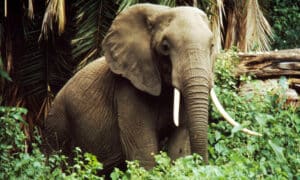
African Savanna Elephant (Loxodonta africana)
The African savanna elephant (Loxodonta africana), also known as the African bush elephant, is not only the largest species of

Asian elephant (Elephas maximus)
Introduction to Asian Elephant Asian elephants, known scientifically as Elephas maximus, are the largest land mammals in Asia. These majestic

Sumatran elephant(Elephas maximus sumatranus)
Introduction The Sumatran elephant, a critically endangered subspecies of the Asian elephant, is native to the Indonesian island of Sumatra.
